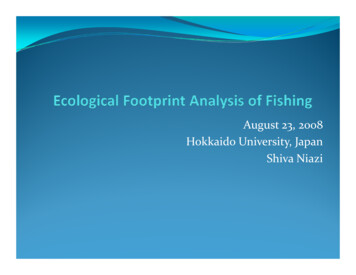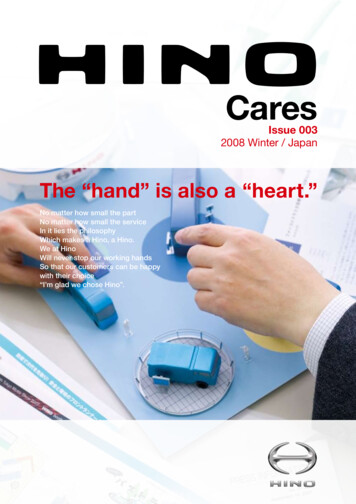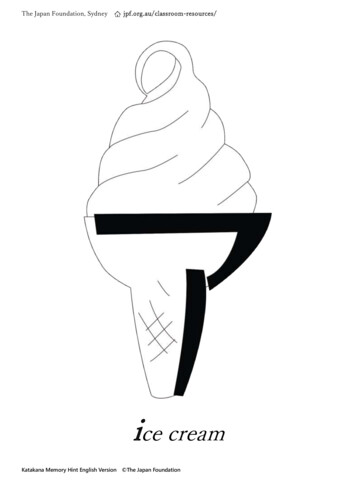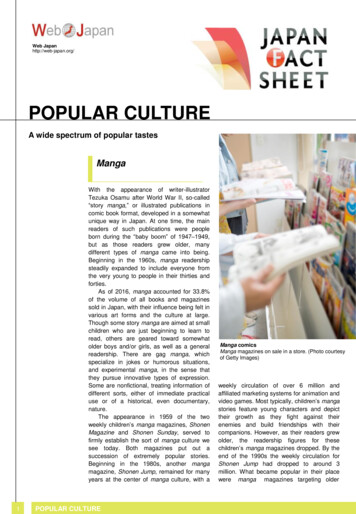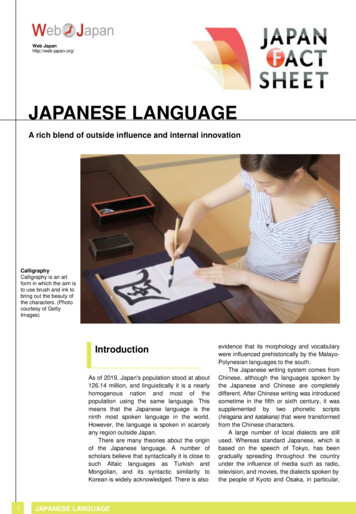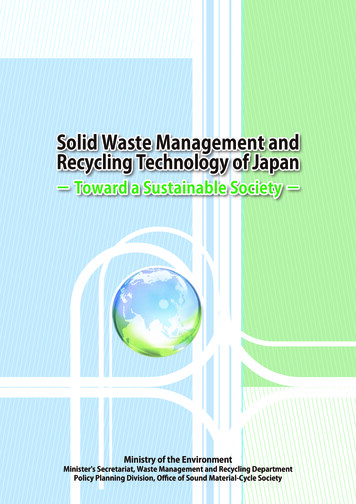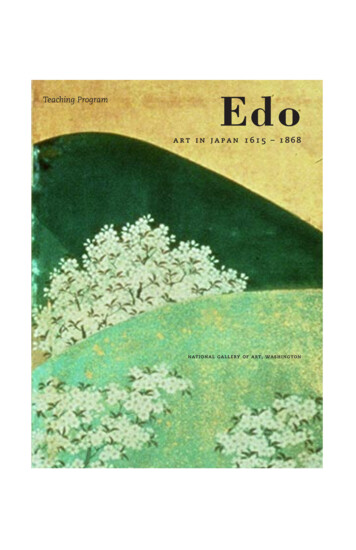
Transcription
edo teach.qxd412/9/9810:42 AMTeaching ProgramPage 1Edoa r t i n j a p a n 1615 – 1868national gallery of art, washington
edo teach.qxd412/9/9810:42 AMPage 2The exhibitionEdo: Art in Japan 1615 – 1868is made possible by NTTExhibition dates:15 November 1998 through15 February 1999
edo teach.qxd412/9/9810:42 AMPage 1EdoArt in Japan 1615 – 1868Teaching ProgramNational Gallery of Art, Washington
edo teach.qxd412/9/9810:42 AMPage 2acknowledgmentsnotes to the readerThis teaching program was written for theThe Japanese government has designatededucation division by Christine Guth, an inde-numerous works of art as National Treasures,pendent scholar. Since receiving her Ph.D. inImportant Cultural Properties, or Important ArtFine Arts from Harvard University in 1976, sheObjects because of their artistic quality, historichas taught at institutions such as Harvard,value, and rarity. Several works with these des-Princeton, and the University of Pennsylvania.ignations are included in this publication.Her recent publications include Art, Tea, andIndustry: Masuda Takashi and the Mitsui CircleDimensions are in centimeters, followed by(Princeton, 1993) and Art of Edo Japan: The Artistinches in parentheses, height preceding width,and the City, 1615–1868 (New York, 1996).and width preceding depth.Concept development and teaching activitiesCover: Watanabe Shikø, Mount Yoshino, earlyby Anne Henderson, Heidi Hinish, and Barbaraeighteenth century, detail from a pair of six-Moore.panel screens; ink, color, and gold on paper,Private Collection, KyotoThanks to Leo Kasun, Elisa Patterson, RuthPerlin, Renata Sant’anna, Takahide Tsuchiya,Title page: Dish with radish and waves design,and Susan Witmer for their assistance withc. 1680s –1690s, Nabeshima ware porcelain,this project.Imaemon Museum of Ceramic Antiques, SagaProduced by Donna Mann.Copyright 1998. All rights reserved.Designed by Carol Beehler.Board of Trustees, National Gallery of Art,Washington
edo teach.qxd412/9/9810:42 AMPage 3contentsEdo: Art in Japan 1615 – 1868Edo StyleSamuraiWork 10 15 19Religion Travel28 23EntertainmentGlossary Chronology33 39 40Activities 42Further ReadingSlide List 46 44 4
edo teach.qxd412/9/9810:42 AMPage 4edo: art in japan 1615 – 1868The Edo period (1615 – 1868)ment. The emperor was a figureheadsaw the flowering of manywho commanded no political author-forms of cultural expression,ity, but his approval was necessaryboth colorful and boisterous, mutedto legitimize the shogun. By puttingand restrained, that we think of todayin place a highly centralized admin-as typically Japanese. These includeistrative organization and strictlykabuki and nō drama, the tea cere-controlling Japan’s contacts withmony (see fig. 1), the martial arts,other countries, Ieyasu and fifteenwoodblock prints, and porcelain. Thissuccessive generations of Tokugawaculturally diverse and extraordinarilyshogun ensured peace and stabilityvibrant period gets its name from thefor an unprecedented two and acity of Edo, now known as Tokyo,half centuries.which became the seat of the govern-figure 1The Tokugawa rulers exercisedment when Tokugawa Ieyasu (1542 –authority through their roughly 2501616) unified the country after a cen-feudal vassals, known as daimyo, totury and a half of warfare.whom they granted fiefs throughoutThe Tokugawa regime was for-the country. In return, these feudalNonomura Ninsei (d. 1695),mally established in 1603, when thelords were expected to lend militaryTea bowl with crescent moonemperor, in recognition of Ieyasu’sassistance when required, to serve theand waves design, c. 1656,supremacy on the battlefield,shogun in various administrativeappointed him shogun, the highestcapacities, and to provide ceremonial12.5 (4 7/8), Tokyo Nationalrank in the military order, and theentertainments and gifts. Their fiefsMuseumtitular head of the military govern-were strategically allocated to keepstoneware with polychromeoverglaze enamels, diameterpotentially dangerous rivals as farfrom Edo as possible. To ensure thatthey did not establish provincialpower bases that might challengeshogunal authority, the daimyo had tospend alternate years in residence inEdo. Even when they returned home,they had to leave wives and family ashostages in Edo.By 1720 Edo, the nation’s administrative capital, had a population ofmore than one million inhabitants —exceeding that of London or Paris atthe time. Kyoto, a city of temples andshrines, the residence of the emperor,and the leading center of arts andcrafts production, had a population ofclose to 400,000. Osaka, popularlyknown as the nation’s kitchenbecause it was the hub of rice trade4 Edo: Art in Japan
edo teach.qxd412/9/9810:43 AMPage 5figure 2and shipping, also had around 400,000make Japan one of the most urban-inhabitants. These metropolises,ized countries in the world (see fig. 2).along with the smaller cities andThe growth of a money economytowns that sprang up across theand resulting concentration of wealthJapanese archipelago, combined toin the urban setting led to a dramaticEdo: Art in Japan 5
edo teach.qxd412/9/9810:43 AMPage 6shift in cultural power over the courseative weavers, dyers, and designers toof the Edo period. Although the rulingsupply her luxurious, trendsettingwarrior or samurai class was at thewardrobe.pinnacle of the social hierarchy, followed by farmers, artisans, and mer-towns and cities, more than eightychants, its members were largelypercent of the population continueddependent on fixed stipends from riceto make a living by farming. Rice wasproduction. The same was true of thethe dominant crop, but to supplementcourt nobility and clergy. The money-this, many farmers began to diversify,based income of merchants and arti-planting cash crops such as cotton,sans, on the other hand, was variablerapeseed, or tobacco and producingand therefore more responsive togoods such as cotton fabrics. The eco-inflationary pressures. Although polit-nomic benefits of these developmentsical power was monopolized by theenabled some farmers to acquiresamurai, artisans and merchantswealth enough to devote themselvesvastly outnumbered them andto cultural pursuits such as poetry,became more affluent and influentialpainting, and calligraphy, previouslyas patrons of the arts.enjoyed only by the urban elite.Through their enthusiastic sup-Literati painters such as Ike Taigaport of visual and performing arts,(1723 – 1776) and Yosa Buson (1716 –such as woodblock prints and kabuki1783) traveled to rural areas to providetheater, this new urban economicinstruction as well as to find newelite had a lasting impact on the dis-markets for their work.tinctive cultural style of the EdoA nationwide system of roadwaysperiod. But traditional patterns ofand waterways fostered communi-patronage did not disappear. Thecation, commerce, and culturalsamurai class required a wide rangeexchange between city and country.of paintings and other arts to decorateTraffic went both ways. Urban fash-their residences. To fill these needs,ions were quickly taken up in thethey retained hereditary lineages ofprovinces, and rural folk paintingsartists, such as the Kano school ofand textiles found favor in the cities.painters, whose themes and stylesThis flow of culture between thedictated official taste of the period.metropolis and the peripheryReligious institutions employed car-enriched the lives of individuals andpenters to build new halls and sculp-fostered the growth of shared culturaltors, painters, and other craftsmen tovalues throughout the Japanesefill them. Members of the imperialislands.family, though financially dependent6 Edo: Art in JapanDespite the phenomenal growth ofThere was also regular, if carefullyon the shogunate, also continuedcontrolled, trade with China, Korea,to support the arts. Following herand the West, primarily through themarriage to Emperor Gomizunoo insouthern port of Nagasaki. The1620, Tøfukumon’in (1607 – 1678)Tokugawa had banned the Portugueseemployed many of Kyoto’s most cre-and Spanish from Japanese ports
edo teach.qxd412/9/9810:43 AMPage 7because of their efforts to gain converts to Catholicism, but they permitted trade with the Dutch, whowere less interested in promoting religion. After 1720, when restrictions onimported books were lifted, providingthey had no religiously subversivecontent, a wide range of foreign booksand pictures filtered into the country.These fueled the thirst for knowledgeand novelty, contributing significantlyto the rich cultural mix of the period.In the 1820s, for instance, the introduction of an imported aniline dyeknown as Prussian or Berlin blue contributed to a craze for prints thatmade extensive use of this startlinglydeep and permanent color (see fig. 3).With the spread of educationalopportunities and the diffusion ofinexpensive books, literacy soaredamong men, women, and children ofall classes. Education, once limited towarriors and courtiers, now becameavailable through temple schools aswell as private academies. Learning toread and write required mastery ofChinese characters as well as two syllabic systems. Although Chinese andJapanese belong to different linguisticsystems, Japan had adopted Chinesecharacters, supplementing them witha complex phonetic syllabary. Thepublication of easy-to-read novels,adopted Confucianism as the statefigure 3instructional manuals, and collectionsideology. The government foundKatsushika Hokusai (1760 –of poetry, many of them with livelyit especially appealing because un-illustrations, helped to make readinglike Buddhism and Shinto, the twoone of the most popular leisure activi-other prevailing ethical systems, itProvinces, c. 1833 – 1834, colorties in town and country.addressed political and moral con-woodblock print, 37.5 x 24.8cerns in a highly pragmatic way. The(14 3/4 x 9 3/4 ), Private Collection,China, long Japan’s cultural mentor, continued to play an importantConfucian value system undergirdedrole, especially in the intellectual andthe Tokugawa social hierarchy as wellartistic spheres. The Tokugawa regimeas the emphasis on filial piety and1849), Amida Waterfall on theKiso Highway, from A Tourof Waterfalls in VariousCaliforniaEdo: Art in Japan 7
edo teach.qxd412/9/9810:43 AMPage 8figure 4loyalty to one’s superior. The moraliz-limited to the pictorial arts, but wasOgata Kørin (1658 – 1716) anding themes common in paintingsalso manifested in other media, espe-commissioned by the shogun, daimyo,cially ceramics (see figs. 4, 5).Ogata Kenzan (1663 –1743),Square dish with cranedesign, c. 1710, stoneware andand their vassals served to reinforceunderglaze iron oxide, widthConfucian ethical values.22.2 (8 3/4 ), Fujita Museum ofArt, Osaka, Important CulturalPropertyMany artistic developments of theby a highly integrated approach to thearts. The Western distinction betweenperiod were informed by a dynamicthe “fine arts” of painting and sculp-tension between Chinese and indige-ture and the “applied arts” of ceram-nous aesthetic values that had charac-ics, metalwork, and lacquer wasterized Japanese culture since ancientunknown. Many artists worked in sev-times. Painters of the orthodox Kanoeral media. Those of the Rinpa school,school specialized in pictorial themesfor instance, were accomplishedand ink painting styles of Chinese ori-painters and calligraphers as well asgin; so too did the more individualis-designers of textiles, lacquer, andtic painters of the literati school. Yetceramics. Nor was there a sharp dis-both groups also incorporated ele-tinction between the visual, literary,ments of Japanese aesthetics. Whileand the performing arts. The tea cere-Chinese pictorial traditions tended tomony is among the many art formsemphasize the potential of the brushthat combine both performative andto create expressive line and texture,visual elements.Japanese aesthetics gave priority to8 Edo: Art in JapanThe Edo period was characterizedMost artists, whether painters,color and surface. The interplaysculptors, potters, lacquerers, orbetween these approaches was notweavers, were organized into heredi-
edo teach.qxd412/9/9810:43 AMPage 9tary workshops, some of which lastedfor many generations. These werestructured along familial lines, withmost members related by blood ormarriage; and those who were notrelated adopted the same familyname. These occupational groups jealously guarded their trade secrets,handing them down from master todisciple. The Kano school of paintersand Gotø school of armorers, whichprimarily served members of thesamurai class, flourished throughoutthe Edo period. Woodblock print workshops were more dependent on thefickle tastes of the public and rarelylasted more than a generation or two.This familial system was the normamong other cultural groups as well.Schools of tea, calligraphy, swordsmanship, and poetry were similarlyorganized into artistic lineages, sometimes with many branches across thecountry. Those desiring to learn a par-figure 5Dish with lotus leaf andgeometric pattern, late 1640s,ticular skill paid a fee to study underHizen ware, porcelain withone of their officially licensed mas-underglaze cobalt blue andters. Mastery in one or more such artspolychrome overglaze enam-was deemed essential to the develop-els, diameter 33 (13), IdemitsuMuseum of Arts, Tokyoment of aesthetic sensibility andcultural literacy. Edo: Art in Japan 9
edo teach.qxd412/9/9810:43 AMPage 10edo styleWhen we refer to a person’sAn acute preoccupation with see-“style,” we are usuallying and being seen is among the mostdescribing the way he ornotable characteristics of Edo periodshe behaves, talks, and dresses. Stylestyle, transcending such regional dif-is an expression of both individualferences. The Edo world thrived onand collective identity, and as such itthe spectacular, and the relationshipis shaped by and reflective of manybetween art and life was constantlyfactors — ethnic, religious, regional,being defined and redefined bysocial, occupational, a
(Princeton, 1993) and Art of Edo Japan: The Artist and the City, 1615—1868 (New York, 1996). Concept development and teaching activities by Anne Henderson, Heidi Hinish, and Barbara Moore. Thanks to Leo Kasun, Elisa Patterson, Ruth Perlin, Renata SantÕanna,Takahide Tsuchiya, and Susan Witmer for their assistance with this project. Produced .



